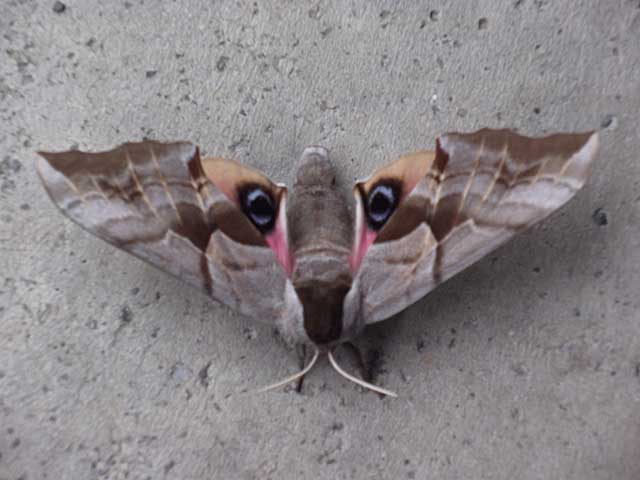Clallam County
Sphingidae
Smerinthus ophthalmica, Port Angeles, Clallam County, Washington,
July 14, 2010, courtesy of Betty Bates.
|
|
Updated as per James P. Tuttle's The Hawk Moths of North America, July 20, 2010 Updated as per Butterflies and Moths of North America website, formerly USGS; July 20, 2010 Dedicated/updated as per personal communication with Betty Bates (Smerinthus opthalmica , July 14, 2010), August 2, 2010 |

Smerinthus ophthalmica, Port Angeles, Clallam County, Washington,
July 14, 2010, courtesy of Betty Bates.
This page is dedicated to Betty Bates who sent me the image of Smerinthus ophthalmica at top of this page.
Betty writes, "My name is Betty Bates, and I live in Port Angeles, WA. (actually halfway between Port Angeles and
Sequim along the Strait of Juan de Fuca). On Wednesday, July 14th, I was sweeping out my garage and right outside my
garage door was this moth (see attached picture). I was fascinated by the colorful "face" that this moth had on its wings.
My sister-in-law checked out her Northwest Guide book to plants and bugs and told me about the moth called,
"Cerisy's Sphinx".
"I did a Google search and found your website. I was wondering if this moth was indeed Cerisy's Sphinx or the Twin Spotted
Sphinx. This is the first time I have seen a moth like this in the 17 years that I have lived here. I have seen many other
types of moths around here but never one with such a colorful and amazing design.
"Any info would be very much appreciated."
I replied, "Your sister-in-law is correct (now (2013) revised to S. ophthalmica).
It is Smerinthus ophthalmica. They are very close in appearance to the Smerinthus cerisyi. One subtle, but consistent, difference is that in
ophthalmica the forewing post median line is formed by the union of two convex arcs while in cerisyi the broader pm line/band is a relative straight series of
line segments/bars. Also not the smoother scalloping of the forewing outer margin in ophthalmica.
"I would like permission to post image, credited to you, to a webpage??
"In which Washington County do you reside?"
It is also likely that Smerinthus jamaicensis does not fly in Washington, although it is reported in southern British Columbia, Canada.
Those specimens from Washington previously listed as S. cerisyi are probably all S. ophthalmica.
The Cascades seem to be a barrier to some of the more eastern species.
A "USGS" indicates the moth is reported in USGS and/or in Moths of Western North America, #2. Distribution of Sphingidae of Western North America, revised, an excellent little booklet available through Paul Opler.
A "WO" after the species name indicates that I have no confirmed reports of this species in Clallam County, but I (William Oehlke) expect that this moth is or might be present.
Please help me develop this list with improved, documented accuracy by sending sightings (species, date, location), preferably with an image, via email to Bill Oehlke.
Sphinginae subfamily
Smerinthini Tribe:
Macroglossinae subfamilyDilophonotini tribe:
Macroglossini tribe:
|
Enjoy some of nature's wonderments, giant silk moth cocoons. These cocoons are for sale winter and fall. Beautiful Saturniidae moths will emerge the following spring and summer. Read Actias luna rearing article. Additional online help available.
Use your browser "Back" button to return to the previous page.
This page is brought to you by Bill Oehlke and the WLSS. Pages are on space rented from Bizland. If you would like to become a "Patron of the Sphingidae Site", contact Bill.
Please send sightings/images to Bill. I will do my best to respond to requests for identification help.
 Show appreciation for this site by clicking on flashing butterfly to the left. The link will take you to a page with links to many insect sites. |